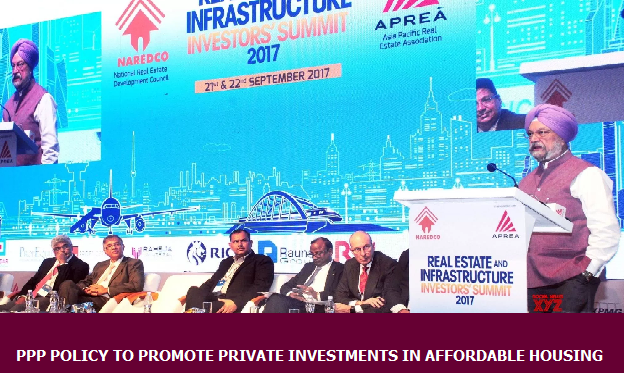(HOT) UPSC Current Affairs 2025 PDF
NEW! The Gist (NOV-2025) | E-BOOKS
PPP POLICY TO PROMOTE PRIVATE INVESTMENTS IN AFFORDABLE HOUSING : Civil Services Mentor Magazine: OCTOBER - 2017

::PPP POLICY TO PROMOTE PRIVATE INVESTMENTS IN AFFORDABLE HOUSING::
Central Government announced a new PPP Policy for Affordable Housing that allows extending central assistance of up to Rs.2.50 lakh per each house to be built by private builders even on private lands besides opening up immense potential for private investments in affordable housing projects on government lands in urban areas.
This policy that gives eight PPP (Public Private Partnership) options for private sector to invest in affordable housing segment. This policy seeks to assign risks among the government, developers and financial institutions, to those who can manage them the best besides leveraging under utilised and un-utilised private and public lands towards meeting the Housing for All target by 2022..
The two PPP models for private investments in affordable housing on private lands include extending central assistance of about Rs.2.50 lakh per each house as interest subsidy on bank loans as upfront payment under the Credit Linked Subsidy Component (CLSS) component of Pradhan MantriAwasyojana (Urban). Under the second option, central assistance of Rs.1.50 lakh per each house to be built on private lands would be provided, in case the beneficiaries do not intend to take bank loans.
Eight PPP options, including six for promoting affordable housing with private investments using government lands have been evolved after extensive consultations with States, promoter bodies and other stakeholders.
The six models using government lands are:
1. DBT Model: Under this option, private builders can design, build and transfer houses built on government lands to public authorities. Government land is to be allocated based on the least cost of construction. Payments to builders will be made by the public authority based on progress of project as per agreed upon milestones and buyers will pay to the Government.
2. Mixed Development Cross -subsidized Housing : Government land to be allotted based on number of affordable houses to be built on the plot offered to private builders, cross subsidizing this segment from revenues from high end house building or commercial development.
3. Annuity Based Subsidized Housing: Builders will invest against deferred annuity payments by the Government. Land allocation to builders is based on unit cost of construction.
4. Annuity-cum-Capital Grant Based Affordable Housing: Besides annuity payments, builders could be paid a share of project cost as upfront payment.
5. Direct Relationship Ownership Housing: As against government mediated payments to builders and transfer of houses to beneficiaries in the above four models, under this option, promoters will directly deal with buyers and recover costs. Allocation of public land is based on unit cost of construction.
6. Direct Relationship Rental Housing: Recovery of the costs by builders is through rental incomes from the houses built on government lands.
Under these six Government land based PPP models, beneficiaries can avail central assistance of Rs.1.00 to Rs.2.50 lakh per house as provisioned under different components of PMAY(Urban). Beneficiaries will be identified as per the norms of PMAY(Urban).
A view would soon be taken on allowing urban housing projects in peripheral villages and talks are going on this regard with the Ministry of Rural Development. Online mechanism for time bound approvals for building plans and construction permits has already been introduced in Mumbai and Delhi and the same would happen soon in 53 cities with population of above one million each.

